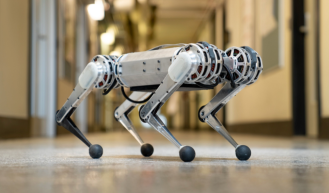Robotic animals are becoming increasingly sophisticated. Mimicking the form and functions of creatures ranging from birds to llamas, robotic animals can perform backflips, navigate treacherous terrain, and right themselves when they stumble — not to mention the softer features, like providing emotional support for the elderly.
But robots have long struggled to mimic real-life animals in one fundamental locomotive ability: running. The main difficulty lies in equipping robots with the ability to maintain high speeds while running across different types of tricky terrain. Unlike animals, most robots don’t automatically adjust their gait when moving from, say, grass to ice.
MIT’s Mini Cheetah robot is a quicker learner. That’s because a team of researchers from MIT’s Improbable AI Lab recently used a machine-learning approach to train the four-legged bot to run fast and efficiently, enabling it to set a new speed record of 8.7 mph.
Like most other quadruped robots, previous iterations of Mini Cheetah were trained to run by human engineers who studied the physics of the robot’s movements and developed algorithms to control its locomotion. This can get time consuming. For example, if the robot kept falling during a specific movement, engineers would have to manually correct the problem.
The upgraded Mini Cheetah uses a learning-based model in which it automatically improves its abilities through experience. In addition to boosting speed, the method enables the bot to learn other locomotive abilities, like moving efficiently with a disabled leg. What’s more, the quadruped can learn through experiences not only on real-world terrain, but also on simulated terrain.
Using simulation tools, the team trained the robot to navigate different types of terrain within simulated environments. Because the simulations don’t need to occur in real time, the robot was able to gain 100 days’ worth of real-world experience in just several hours. The model is something like a sped-up version of how humans and other animals learn to navigate their environment: through repeated trial and error.
Scalability is a key benefit of the system. Unlike other methods where human engineers have to manually predict and account for different problems the robot will encounter in the real world, this learning-by-experience method automates most of the work and lets the robot mature out of its clumsy toddler-phase in a simulated environment where it won’t incur wear and tear.
To be sure, Mini Cheetah isn’t the fastest legged robot. The six-legged OutRunner robot can run up to 45 mph on a treadmill, while MIT’s Cheetah quadruped ran 28.3 mph in 2012.
But speed wasn’t the main goal behind MIT’s new iteration of Mini Cheetah. Rather, the team hopes their learning paradigm can help improve all sorts of robotic systems, such as by training robotic hands how to better pick up and manipulate objects. Toward that goal, the researchers soon plan to make their code available to the public.
We’d love to hear from you! If you have a comment about this article or if you have a tip for a future Freethink story, please email us at tips@freethink.com.
